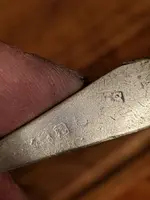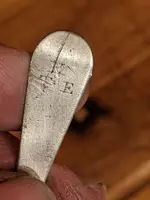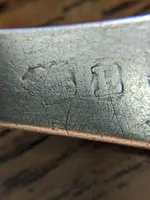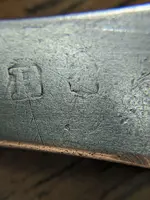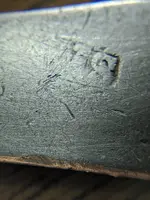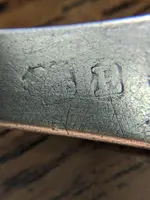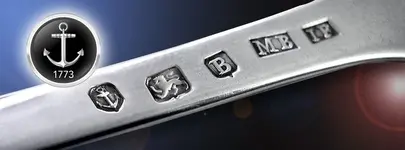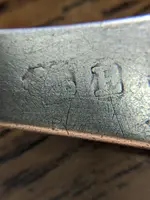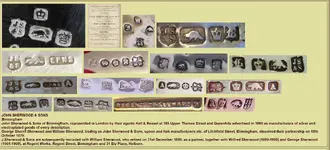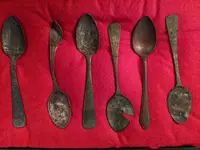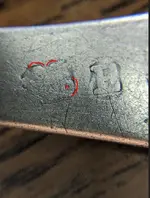Red. The first mark, the animal, is the standard mark. Sterling silver.
The second mark, the E, is the date mark.
The third mark, which is quite worn, is the sovereign, or duty mark.
The fourth mark, it's two letters, is the makers mark.
However, aside from all this, looking at the design of the piece and the monogram, the metal itself tells me it's silver. If it was plated it would be so obvious. I've seen enough sterling and plate to know the difference.
How much do you really know about British hallmarks though?
I already said that the E may be a date letter, but that doesn’t mean the piece is silver. It could be the manufacturer’s own date letter sequence, would then be an unofficial silver plate mark and you would need to know who the manufacturer was to be able to interpret it.
The E letter is serifed, upper case, in a square shield with clipped corners and it has a
flat base. This cannot be a London silver mark because there is no London date letter which has that format. The closest would be 1800 but the shield would have an
indent at the bottom and a protruding point. Furthermore, the item would have to carry the city mark for London which was a front facing leopard’s head with a crown in a shield with a rounded bottom. The full set of marks (excluding the maker mark) would be like this:

That rules out London. There are then only a limited number of British assay offices who have ever used a serifed upper case E in a square shield with clipped corners and a flat base. These are:
Birmingham (1853), but if it were a Birmingham piece it would have to carry the city mark, which was an anchor in a shield with clipped corners. Like this:

Chester (1705, 1801, 1823 or 1888), but again it would have to carry the city mark for Chester, which changed from time to time but is shown in each of the examples below:
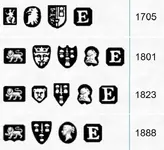
Dublin (1801), but Dublin never used an animal mark of any kind. Again the piece would have to have their city mark, which was Hibernia seated and a crowned harp in a lozenge with clipped corners for the fineness mark. Like this:

The same applies to all of the other possibilities….
Edinburgh (1784/5):
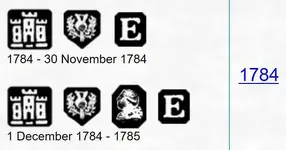
Newcastle (1795, 1819 or 1843):
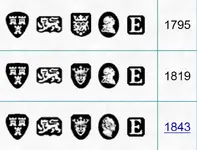
Sheffield (1799 or 1848):

York (1780):

What many Americans seem not to understand is that (unlike in America) our hallmark system has been specified in detail and heavily regulated for centuries. Each piece is individually assayed for its silver content and the city which does this must apply its identifying mark in addition to the silver mark. There is no laxity in the style for the marks used and everything I have shown above represents the set of “compulsory marks”. They
all have to be present on a piece of silver and will always follow a standard format and rigid style in each individual assay office. Any deviation from this tells you that you don’t have a hallmark and the piece is not silver. Any marks a piece like that has will have been applied by the manufacturer in an unregulated manner and, over here, are known as “pseudo hallmarks” which have no official credence.
